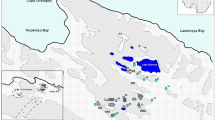Abstract
The 16 priority PAHs were qualitatively and quantitatively assessed in snow samples collected at 9 stations in the City of Khabarovsk and at 3 stations in the Bol’shekhekhtsirsky State Nature Reserve during 2014–2015 and 2016–2017. The HPLC analysis revealed that the range of Σ13PAH concentrations detected in snow collected in the Khabarovsk City area during 2015 and 2017 were between 42.83 and 441.13 and 43.00–695.73 ng/L, while in the reserve area concentrations were 34.77–59.61 and 38.92–79.80 ng/L, respectively. The markers identified pyrogenic, petrogenic and mixed sources of emission. The toxic equivalent quantity varied in the urban and reserve areas from 0.89 to 40.62 ng/L and from 1.01 to 2.92 ng/L accordingly. BaP mainly contributed (56.4%–86.2%) to the total PAH toxicity. The transboundary transfer of BaP and anthracene was revealed in the reserve area. The quality of the snow polluted by polyarenes is satisfactory in the study areas except for city roads.

Similar content being viewed by others

References
Chen S-C, Liao C-M (2006) Health risk assessment on human exposed to environmental polycyclic aromatic hydrocarbons pollution sources. Sci Total Environ 366:112–123
Cincinelli A, Bubba M, Martellini T et al (2007) Gas-particle concentration and distribution of n-alkanes and polycyclic aromatic hydrocarbons in the atmosphere of Prato (Italy). Chemosphere 68:472–478
Clément N, Muresan B, Hedde M, François D (2015) PAH dynamics in roadside environments: influence on the consistency of diagnostic ratio values and ecosystem contamination assessments. Sci Total Environ 538:997–1009
GISMETEO (Geographical Information Systems Meteorology) weather diary, Khabarovsk (2017) https://www.gismeteo.ru/diary/4862/. Accessed 12 May 2017
Gouin T, Wilkinson D, Hummel S et al (2010) Polycyclic aromatic hydrocarbons in air and snow from Fairbanks, Alaska. Atmos Pollut Res 1(1):9–15
Hanedar A, Alp K, Kaynak B et al (2011) Concentrations and sources of PAHs at three stations in Istanbul, Turkey. Atmos Res 99:391–399
Hygienic Standards GN 2.1.5.1315-03 (2003) Maximum permissible concentrations (MPC) of Chemicals in Bodies of Water Used as Sources of Industrial and Drinking Water Supply and in Drinking and Domestic Use. Moscow (in Russian)
Inengite AK, Oforka NC, Osuji Leo C (2012) Sources of polycyclic aromatic hydrocarbons in an environment urbanised by crude oil exploration. Environ Nat Resour Res 2(3):62–70
ISO (International Standardization Organization) (2002) 17993:2002 Water quality – Determination of 15 polycyclic aromatic hydrocarbons (PAH) in water by HPLC with fluorescence detection after liquid-liquid extraction, Ed1
Kim KH, Jahan SA, Kabir E et al (2013) A review of airborne polycyclic aromatic hydrocarbons (PAHs) and their human health effects. Environ Int 60:71–80
Kwon EE, Castaldi MJ (2012) Mechanistic understanding of polycyclic aromatic hydrocarbons (PAHs) from the thermal degradation of tires under various oxygen concentration atmospheres. Environ Sci Technol 46:12921–12926
Levshina SI (2012) Petroleum products and phenols in snow cover in Khabarovsk, Southern Russian Far East. Water Air Soil Pollut 223(6):3553–3563
Li PH, Wang Y, Li Y et al (2016) Gas-particle partitioning and precipitation scavenging of polycyclic aromatic hydrocarbons (PAHs) in the free troposphere in southern China. Atmos Environ 128:165–174
Liu Y, Chen L, Zhao J et al (2010) Polycyclic aromatic hydrocarbons in the surface soil of Shanghai, China: concentrations, distribution and sources. Org Geochem 41:355–362
Nemirovskaya IA (2001) Hydrocarbons in the northern Barents Sea. Geochem Int 9:908–916
Nisbet ICT, LaGoy PK (1992) Toxic equivalency factors (TEFs) for polycyclic aromatic hydrocarbons (PAHs). Regul Toxicol Pharmacol 16(3):290–300
Pavlov VE, Morozov SV, Raputa VF et al (2011) Investigation of polyaromatic hydrocarbons in the influence zone of Barnaul. Chem Benefit Sustain Dev 19:287–294 (In Russian)
Soclo HH, Garrigues PH, Ewald M (2000) Origin of polycyclic aromatic hydrocarbons (PAHs) in coastal marine sediments: case studies in Cotonou (Benin) and Aquitaine (France) areas. Mar Pollut Bull 40(5):387–396
USEPA (US Environmental Protection Agency) (1993) Provisional guidance for quantitative risk assessment of polycyclic aromatic hydrocarbons. Office of Research and Development, U.S. Environmental Protection Agency, Washington, DC
Vasilevich MI, Gabov DN, Beznosikov VA et al (2009) Organic matter in snow cover in the influence zone of emissions from a pulp-and-paper mill. Water Resour 36(2):170–176
Vasilevich MI, Beznosikov VA, Gabov DN (2014) Polycyclic aromatic hydrocarbons in snow of the taiga zone background territories of the European Northeast of Russia. Geoekologiya 4:337–343 (in Russian)
White AJ, Chen J, Teitelbaum SL et al (2016) Sources of polycyclic aromatic hydrocarbons are associated with gene-specific promoter methylation in women with breast cancer. Environ Res 145:93–100
Yu H (2002) Environmental carcinogenic polycyclic aromatic hydrocarbons: photochemistry and phototoxicity. J Environ Sci Health C 20(2):149–183. https://doi.org/10.1081/GNC-120016203
Yunker MB, Macdonald RW, Vingarzan R et al (2002) PAHs in the Fraser River basin: a critical appraisal of PAH ratios as indicators of PAH source and composition. Org Geochem 33:489–515
Zhang L, Chen R, Lv J (2016) Spatial and seasonal variations of polycyclic aromatic hydrocarbons (PAHs) in ambient particulate matter (PM10, PM2.5) in three mega-cities in China and identification of major contributing source types. Bull Environ Contam Toxicol 96:827–832
Zhuravleva NV, Potokina RR, Ismagilov ZR et al (2014) Pollution of a snow cover by polycyclic aromatic hydrocarbons and toxic elements based on the example of Novokuznetsk. Chem Benefit Sustain Dev 22(7):445–454 (In Russian)
Acknowledgements
The author expresses her sincere gratitude to the leading engineers of the Institute of Water and Ecology Problems of the Far East, Russian Academy of Sciences, G.M. Filippova and A.G. Zhukov for their help with HPLC analysis. Thanks are also due to the staff of the Bol’shekhekhtsirsky State Nature Reserve for their assistance in snow sampling.
Author information
Authors and Affiliations
Corresponding author
Rights and permissions
About this article
Cite this article
Levshina, S. Distribution and Characteristic of PAHs in snow of the Urban and Reserve Areas of Southern Far East Russia. Bull Environ Contam Toxicol 102, 160–167 (2019). https://doi.org/10.1007/s00128-018-02533-6
Received:
Accepted:
Published:
Issue Date:
DOI: https://doi.org/10.1007/s00128-018-02533-6



